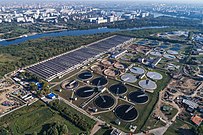
Back Kläranlage ALS معالجة الصرف الصحي Arabic Ташландыҡ һыуҙы таҙартыу Bashkir Kleaolog BAR Пречистване на отпадни води Bulgarian পয়ঃশোধন Bengali/Bangla Tractament d'aigües residuals Catalan Čištění odpadních vod Czech Abwasserentgiftung German Tratamiento de aguas residuales Spanish
| Sewage treatment | |
|---|---|
| Synonym | Wastewater treatment plant (WWTP), water reclamation plant |
| Position in sanitation chain | Treatment |
| Application level | City, neighborhood[1] |
| Management level | Public |
| Inputs | Sewage, could also be just blackwater (waste), greywater[1] |
| Outputs | Effluent, sewage sludge, possibly biogas (for some types)[1] |
| Types | List of wastewater treatment technologies |
| Environmental concerns | Water pollution, Environmental health, Public health, sewage sludge disposal issues |
Sewage treatment (or domestic wastewater treatment, municipal wastewater treatment) is a type of wastewater treatment which aims to remove contaminants from sewage to produce an effluent that is suitable to discharge to the surrounding environment or an intended reuse application, thereby preventing water pollution from raw sewage discharges.[2] Sewage contains wastewater from households and businesses and possibly pre-treated industrial wastewater. There are a high number of sewage treatment processes to choose from. These can range from decentralized systems (including on-site treatment systems) to large centralized systems involving a network of pipes and pump stations (called sewerage) which convey the sewage to a treatment plant. For cities that have a combined sewer, the sewers will also carry urban runoff (stormwater) to the sewage treatment plant. Sewage treatment often involves two main stages, called primary and secondary treatment, while advanced treatment also incorporates a tertiary treatment stage with polishing processes and nutrient removal. Secondary treatment can reduce organic matter (measured as biological oxygen demand) from sewage, using aerobic or anaerobic biological processes. A so-called quarternary treatment step (sometimes referred to as advanced treatment) can also be added for the removal of organic micropollutants, such as pharmaceuticals. This has been implemented in full-scale for example in Sweden.[3]
A large number of sewage treatment technologies have been developed, mostly using biological treatment processes. Design engineers and decision makers need to take into account technical and economical criteria of each alternative when choosing a suitable technology.[4]: 215 Often, the main criteria for selection are: desired effluent quality, expected construction and operating costs, availability of land, energy requirements and sustainability aspects. In developing countries and in rural areas with low population densities, sewage is often treated by various on-site sanitation systems and not conveyed in sewers. These systems include septic tanks connected to drain fields, on-site sewage systems (OSS), vermifilter systems and many more. On the other hand, advanced and relatively expensive sewage treatment plants may include tertiary treatment with disinfection and possibly even a fourth treatment stage to remove micropollutants.[3]
At the global level, an estimated 52% of sewage is treated.[5] However, sewage treatment rates are highly unequal for different countries around the world. For example, while high-income countries treat approximately 74% of their sewage, developing countries treat an average of just 4.2%.[5]
The treatment of sewage is part of the field of sanitation. Sanitation also includes the management of human waste and solid waste as well as stormwater (drainage) management.[6] The term sewage treatment plant is often used interchangeably with the term wastewater treatment plant.[4][page needed][7]
- ^ a b c "Sanitation Systems – Sanitation Technologies – Activated sludge". SSWM. 27 April 2018. Retrieved 31 October 2018.
- ^ Khopkar, S.M. (2004). Environmental Pollution Monitoring And Control. New Delhi: New Age International. p. 299. ISBN 978-81-224-1507-0.
- ^ a b Takman, Maria; Svahn, Ola; Paul, Catherine; Cimbritz, Michael; Blomqvist, Stefan; Struckmann Poulsen, Jan; Lund Nielsen, Jeppe; Davidsson, Åsa (15 October 2023). "Assessing the potential of a membrane bioreactor and granular activated carbon process for wastewater reuse – A full-scale WWTP operated over one year in Scania, Sweden". Science of the Total Environment. 895: 165185. Bibcode:2023ScTEn.895p5185T. doi:10.1016/j.scitotenv.2023.165185. ISSN 0048-9697. PMID 37385512. S2CID 259296091.
- ^ a b Cite error: The named reference
Marcos2was invoked but never defined (see the help page). - ^ a b Jones, Edward R.; van Vliet, Michelle T. H.; Qadir, Manzoor; Bierkens, Marc F. P. (2021). "Country-level and gridded estimates of wastewater production, collection, treatment and reuse". Earth System Science Data. 13 (2): 237–254. Bibcode:2021ESSD...13..237J. doi:10.5194/essd-13-237-2021. ISSN 1866-3508.
- ^ "Sanitation". Health topics. World Health Organization. Retrieved 23 February 2020.
- ^ George Tchobanoglous; H. David Stensel; Ryujiro Tsuchihashi; Franklin L. Burton; Mohammad Abu-Orf; Gregory Bowden, eds. (2014). Metcalf & Eddy Wastewater Engineering: Treatment and Resource Recovery (5th ed.). New York: McGraw-Hill Education. ISBN 978-0-07-340118-8. OCLC 858915999.
© MMXXIII Rich X Search. We shall prevail. All rights reserved. Rich X Search



